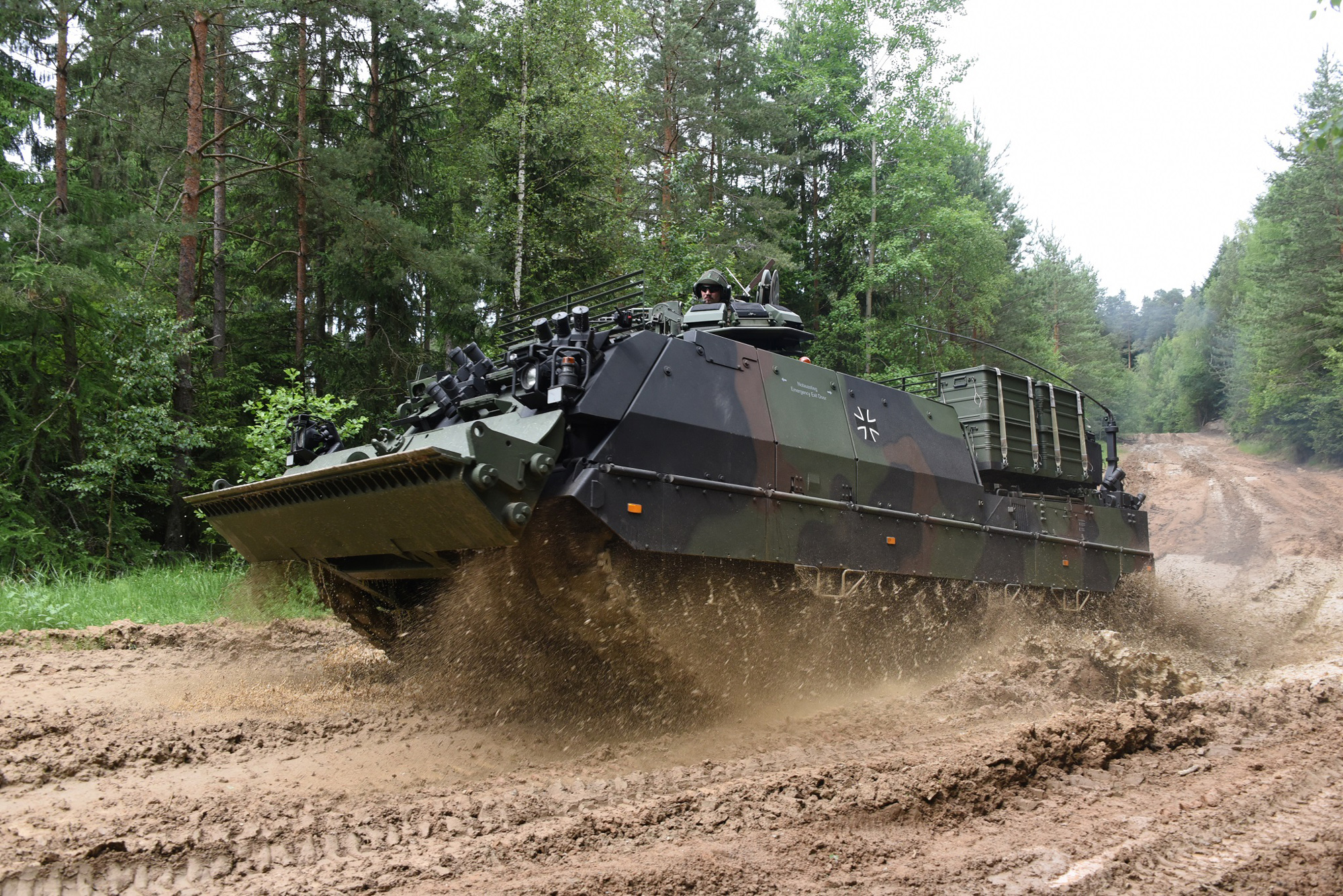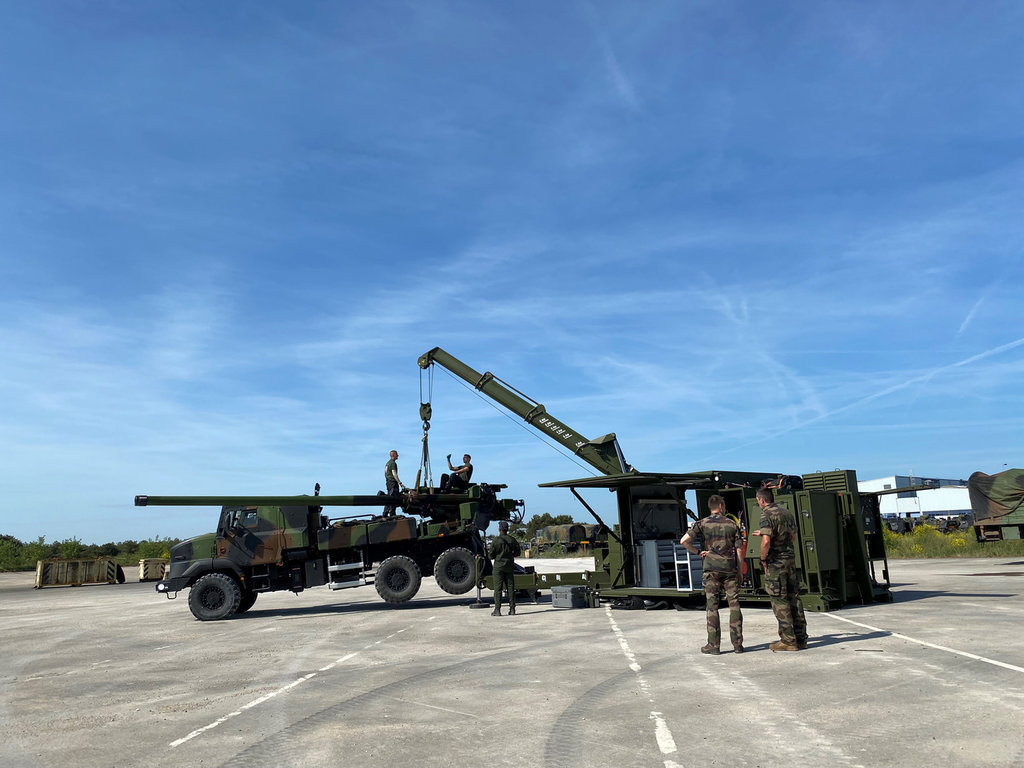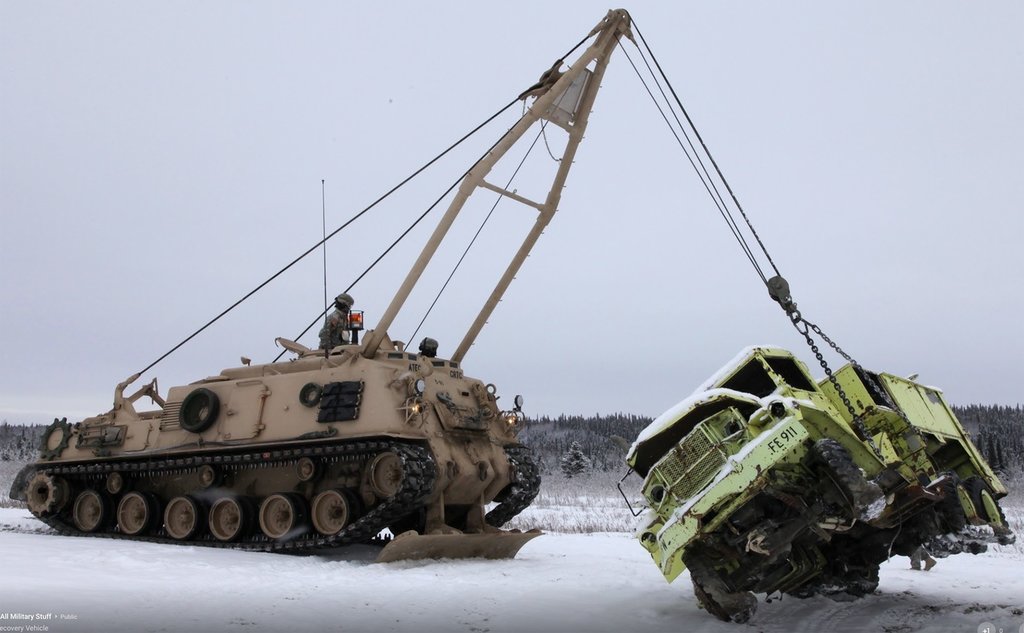Feature
Running repairs: battlefield military workshops
The ability to conduct repairs to armoured vehicles during times of conflict has been thrust to the spotlight following Russia’s large-scale invasion of Ukraine. Tim Fish reports.

The ability to conduct battlefield repairs is considered to be a key enabler in warfare, with industry providing a range of solutions to services, such as Rheinmetall’s Buffalo system. Credit: Rheinmetall
In high-intensity conflict where battles are fought with increasing rapidity it is essential to retain as many platforms as possible in the field, functioning and operational to allow commander to harness their capabilities.
For armies this means sustaining as much of their force of armoured vehicles and artillery on or near the battlefield as possible for decisive effect and to ensure success in potential engagements. With stockpiles of military equipment considerably reduced since the Cold War, especially for Nato, a key part of maintaining capability in the field is for the quick battle damage repair (BDR) of equipment as close to the frontline as possible to enable it to be used again with the minimum of delay.
The invasion of Ukraine has brought the importance of a BDR capability into sharp focus. Russian forces have targeted Ukraine’s weapons factories in an effort to damage the defence industrial base and prevent the Ukrainian Armed Forces from repairing vehicles and other equipment. The early part of the war saw missile strikes on Ukraine’s Myshalev Factory used to repair tanks and the State Aircraft Repair Plant used to maintain the MiG-29s, for example.
Fixed sites like workshops and maintenance facilities are vulnerable to attack and these host important machinery like cranes and machine tools and host skilled workers including mechanics, electricians and welders with vital expertise. These sites are able complete BDR tasks including the repair and replacement of damaged components and assemblies, turrets, powerpacks, running gear, wheels and tracks, damaged armour elements, and carry out welding and cutting.
A diagnosis of all grades of repair to inform the commander of the likely asset down time as well as a prompt allocation and planning of required repair tasks is also completed.
As a result of the strikes on infrastructure, the early part of the war also saw captured Russian vehicles, such as BMP-3 infantry combat vehicles, artillery guns and T-80 tanks, recovered repaired and put back into service with Ukraine’s forces using a larger number of small garages and secret repair yards that are less identifiable.
If we can find those five or 10 things that – if we spend time on – we can affect 20 different tasks that account for what soldiers are supposed to do to perform their jobs that's something worthwhile if we can help focus their time
Joseph Patterson, OHWS programme manager
Facilities on the frontline
In the Russo-Ukraine War, Ukrainian territory is the battlefield, and these facilities are on the frontline, which means they can return equipment to service thus contributing to the ability of Ukraine’s forces to keep up the fight. But it raises questions for other armies how they would seek to repair damaged vehicles on or close to the frontline.
“It’s a matter of speed, how quickly can you get the vehicle back into the battle and reduce the downtime,” Christoffer Gregers Glaesel, managing director of Glaucus, told Global Defence Technology. “If you have to transport a very heavy vehicle like a tank or artillery piece back for repair at a stationary workshop it involves a lot of logistics, manpower and time,” he said.

The FRSN system from Glaucus has been acquired by a number of international operators and has been provided to Ukraine to aid the country in its fight against Russia. Credit: Glaucus
Glaucus manufactures the Forward Repair Station Nato (FRSN) system, a mobile workshop that contains all the machinery and equipment needed to repair almost any military vehicle. The company has supplied the Danish Army with 15 FRSN units, nine of which Denmark has donated to Ukraine.
The FRSN includes an on-board 7t crane, 70 kVA multi-fuel generator unit, 10 bar 900lt/min 100lt air compressor, electrical and pneumatic welders, diagnostic equipment and a variety of tooling, all in a covered workshop that is fitted onto a 20 ft. Nato STANAG flatrack easily transported by a military truck.
The crane has the capability to lift a 6,800kg power pack out of Leopard 2 main battle tank. The generator can provide electrical power for all the sub-systems, lighting and heating as well as provide an external power source.
But in Ukraine, Glaesel said that the FRSN had been used to replace the worn-out barrels on 155mm artillery systems – an valuable piece of weaponry for Ukraine – that was a “really valuable lesson” about how important front line support provided by mobile workshops can be.
Using a worn-out gun barrel will reduce accuracy, which means more rounds will be needed to destroy a target increasing the cost of operating the weapon due to the ammunition. Glaesel explained that although the FRSN crane is a one-point it has been designed for this job and it was used to replace artillery barrels in less than two hours. “This was done very close to the frontline rather than losing one, two, or even three days to take it to a facility,” he added.
International markets for BDR
As well as the Danish Army, Glaucus has sold an undisclosed number of FRSN systems to the US Army. The French Army has also completed testing on FRSN in 2022. The benefit of FRSN is that it includes all the equipment support systems available in one containerised solution instead of bringing all the different elements separately.
Whilst he would not state whether Glaucus had representatives in Ukraine to train and support Ukrainian forces using the FRSN, Glaesel said that the company was “in direct contact with the with the end users out there and ready to support with whatever they need.”
The FRSN is like a “Leatherman multi-tool” with the tools and equipment “to solve almost everything”, Glaesel said. “[FRSN] is basically a gap filler between the fixed structured repair facility and the armoured recovery vehicle (ARV).”
ARVs are used to pull damaged vehicles from the battlefield and are usually based on a tank or other armoured fighting vehicle chassis to provide the mobility needed to access off-road areas where tracked armoured vehicles may be damaged. Often fitted with a crane, winch and dozer, and with a mechanic included as one of the three-person crew, it means ARVs can have the capability to perform some repair functions.

An M88 Armored Recovery Vehicle lifts a truck on snow. Snow and ice can render the ARV ineffective in recovery operations. Credit: US DoD
In March 2023 it was announced that Canada is sending the Bergepanzer-3 (Buffalo) ARV to Ukraine as part of its support package. The Canadian Government is also sending Leopard 2 tanks to Ukraine, which the Buffalo is based on, so is best able to carry out evacuation and repairs. Its crane can lift turrets and it contains a spare power pack.
A spokesperson from Rheinmetall, which manufactures the Buffalo ARV, told Global Defence Technology that the vehicle “can support certain work” such as engine replacement or cutting/welding. “It is also well suited for BDR in a sense of improvised solutions such as using a welder to put broken/destroyed parts back together, or simply cutting off damaged parts that are blocking something,” the spokesperson added.
The Buffalo has a 30t hydraulic pivoting crane, it can pull loads up to 70 tonnes and with triple pull loads up to 105 tonnes. The Battlefield Recovery System means that it can recover damaged vehicles under armour using the crane and winches. It also hosts cutting and welding equipment powered by an onboard generator and additional tools such as an impact wrench, chain saws, lights and pulleys.
According to Rheinmetall, the Buffalo will be in-service in 12 countries including Germany, Greece, Canada, Czech Republic, Hungary, the Netherlands, Spain, Sweden, Switzerland, Singapore, Indonesia, and Ukraine. Buffalo recovery kits are also used in France, South Korea, and the UAE.
“Basically, it can be said that the ARVs are following the MBTs and their requirements. Thus, there is a need for modernisation, e.g., in protection, mobility, C4I, etc,” the spokesperson said. “There is an increased interest, especially in northern and eastern Europe but also overseas. Interoperability and inter-changeability between user nations are becoming more important.”
Earlier in January, the US announced it would send 31 Abrams tanks to Ukraine along with eight M88 ARVs, that can provide recovery and battlefield repair services including turret and power pack replacements. But it is not just tracked ARVs that are important. Because of the trend towards more wheeled medium armoured vehicles in army fleets, Rheinmetall has developed a BDR variant of its 8x8 Boxer armoured personnel carrier for the Australian Army. Meanwhile KMW has also developed a BDR variant of its 4x4 Dingo armoured vehicle.